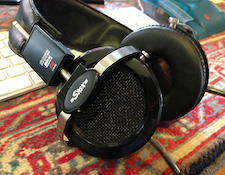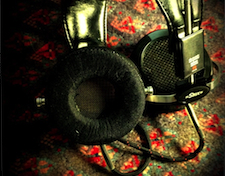It’s the time of year for saving money!

A couple of weeks back I received an email from an old
acquaintance who was selling some gear, including a pair of Stax SR-X mark 3
headphones. I sent him back an email expressing interest in the Stax’s, but he
replied that they had been sold already, to my publisher, Jerry Del Colliano.
Damn…
I called Jerry up and said, “Jerry! WTF! You bought the Stax
headphones I wanted. Do you even own an energizer for them?” Jerry replied,
“Hell no, I don’t have an energizer. I bought them for you. Now you can do an
article comparing a pair of Stax SR-X Mark 3 with new earpads (which I had
recently fitted on my pair) with one that has the originals.” And, so, due to
my publisher’s largesse, I shall do exactly that.
When Jerry’s pair of Stax arrived I compared them to my own
pair. It was immediately obvious that Jerry’s pair was of a newer vintage – the
leather headband, cabling, and plastic part were all in slightly better, less
time-ravaged, shape. Also there was a slight difference to the texture of their
metal housings. Jerry’s pair had a slightly better finish.
The earpads on Jerry’s Stax displayed the same wear pattern as
the set that had been on my pair originally- all the pleather (that’s what I
call fake leather) covering had flaked off, revealing a soft cloth underneath.
The original pads without their leather outer coating are noticeably softer
than new earpads, so they do compress more when you put them on. The big $49
question (the price of new earpads) is whether there is a difference in sound
as a result.
Now if you spend any time perusing the pages of Head-Fi, you’ll
find plenty of threads about earpad mods. Obviously, with some earphones
changing the earpads can make a substantial difference in how they sound. My
Grado RS-1s sound much better with new earpads that that I got via Amazon than
they did with the originals, which were one step away from getting gooey and
weird. But some of the threads where users claim vast differences between leather
and cloth earpads on Stax leave me with a feeling of, “yeah, SURE…”
You would think comparing two of the same brand and model
earphone would be as simple as turn on a source, plug in earphone A, listen,
then plug in earphone B, listen, and make comparisons; but in the real world
things are not so simple.
When I began comparing the two Stax SR-X Mark 3s I noticed even
when using the same amplifier, a Stax SRM-1/Mk 2, the two headphones had
slightly different output levels. My older set of SR-X Mark 3s (with the new
earpads) were approximately 1.5 dB more sensitive. Now if I hadn’t noticed the
difference I might have concluded that the Stax with the new earpads were
“better” because they sounded “bigger.” Even a 1.5 dB difference can do that.
So before I could do an A/B, I needed to find the right volume
settings so that the two headphones had equal output levels. For this I used
the 1 kHz tone from the AudioTest App for my Mac and the dB meter in Audio
Tools on my iPhone to match levels. Now I was ready for some comparisons.

The first and as I later discovered, most profound, difference
between the two earpad versions was how they felt. The older “cloth” earpads
were slightly scratchy on my ears and it took a bit of time to adjust them so
that I didn’t feel the urge to remove them and scratch the itch that they
created. After a bit of adjustment the itchiness subsided. The new Stax earpads
felt much better on my ears, but after about fifteen minutes of listening I
noticed that my ears got rather warm (overheating?) because the pleather
material doesn’t breathe, so it traps heat and moisture beneath it. On warm
days this could get sticky…
The cloth pads did allow my ears to breathe and after fifteen
minutes I didn’t have the strong urge to remove and dry off the pads or my
ears.
But you’re probably more interested in the sonic differences,
right? Well, using high-resolution DSD sources (primarily my own recordings) I
couldn’t discern any sonic differences between the two earphones. To my ears
they both sounded great – with wonderfully natural midranges, well-controlled
bass, and silky highs. My conclusion, with the Stax SR-X mark 3 headphones the
primary reason for replacing the earpads would be comfort, not sound. And for
some folks, the older, now cloth earpads may be even be a better option,
especially in warm environment, since they allow some moisture to escape from
under your ears.
Now, just because a pad change on the Stax SR-X Mark 3s made no
sonic difference doesn’t mean that ALL earpad swaps are a waste of time and
money (if sonic changes are your goal), merely that in this case there were no
discernable sonic changes.
The final question is will I order up another pair of SR-X mark
3 earpads to replace the used set on Jerry’s pair of earphones? Probably not.
It’s nice to have a summer and a winter pair of Stax SR-X mark 3 earphones.
So the final question is pretty simple, “Jerry, can a borrow
your Stax SR-X mark 3 headphones for a while?”





